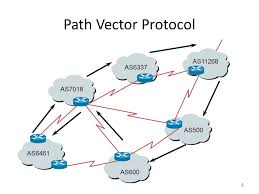A path vector protocol is a computer network routing protocol which maintains the path information that gets updated dynamically. Updates which have looped through the network and returned to the same node are easily detected and discarded. This algorithm is sometimes used in Bellman–Ford routing algorithms to avoid "Count to Infinity" problems.
It is different from the distance vector routing and link state routing. Each entry in the routing table contains the destination network, the next router and the path to reach the destination.
Path Vector Messages in BGP: The autonomous system boundary routers (ASBR), which participate in path vector routing, advertise the reachability of networks. Each router that receives a path vector message must verify that the advertised path is according to its policy. If the messages comply with the policy, the ASBR modifies its routing table and the message before sending it to the next neighbor. In the modified message it sends its own AS number and replaces the next router entry with its own identification.
BGP is an example of a path vector protocol. In BGP the routing table maintains the autonomous systems that are traversed in order to reach the destination system. Exterior Gateway Protocol (EGP) does not use path vectors.
It has three phases:
1.)Initiation 2.)Sharing 3.)Updating

